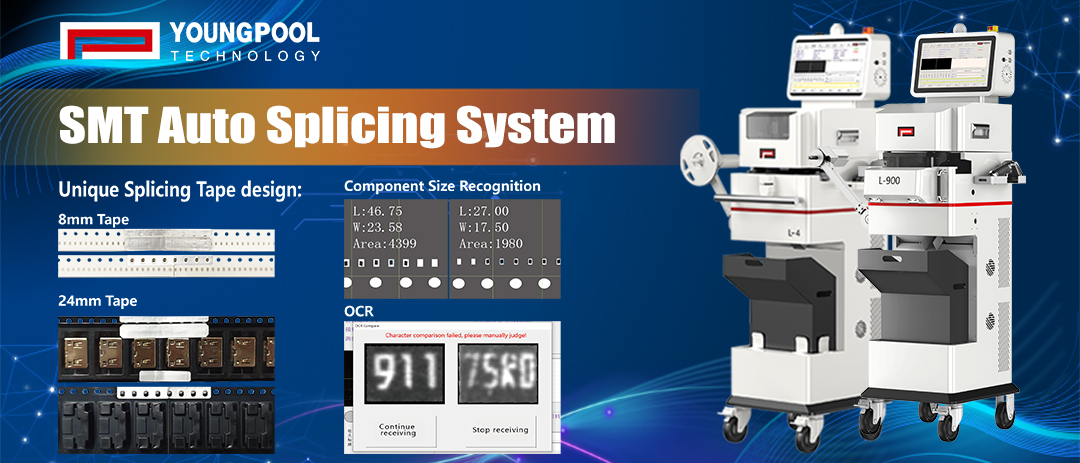Ńé½ŃāåŃé┤Ńā¬
µ¢░ŃüŚŃüäŃā¢ŃāŁŃé░
Ńé╣ŃāŚŃā®ŃéżŃéĘŃā│Ńé░ŃāåŃā╝ŃāŚŃü«ÕżÜµ¦śŃü¬Õ╣ģŃü«õ║ƵÅøµĆ¦Ńü½ŃéłŃéŖŃĆüSMTŃü«ÕłćŃéŖµø┐ŃüłŃüīń░Īń┤ĀÕī¢ŃüĢŃéīŃüŠŃüÖŃĆé
Sep 05, 2025
Ńü¦
SMTńö¤ńöŻ
ńĢ░Ńü¬ŃéŗŃéŁŃāŻŃā¬ŃéóŃāåŃā╝ŃāŚÕ╣ģŃü»ŃĆüńĢ░Ńü¬ŃéŗŃāæŃāāŃé▒Ńā╝ŃéĖŃéĄŃéżŃé║Ńü«ķā©ÕōüŃü½Õ»ŠÕ┐£ŃüŚŃü”ŃüäŃüŠŃüÖŃĆéõĖĆĶł¼ńÜäŃü¬õ╗Ģµ¦śŃü»ŃĆü8mmŃĆü12mmŃĆü16mmŃĆü24mm’╝łŃüŖŃéłŃü│32mmŃéä44mmŃü¬Ńü®Ńü«Õ╣ģÕ║āŃü«ŃééŃü«’╝ēŃü¦ŃüÖŃĆé8mmÕ╣ģŃü»õĖ╗Ńü½µŖĄµŖŚÕÖ©ŃéäŃé│Ńā│ŃāćŃā│ŃéĄŃü¬Ńü®Ńü«Õ░ÅÕ×ŗÕÅŚÕŗĢķā©ÕōüŃü½õĮ┐ńö©ŃüĢŃéīŃĆüÕ░ÅÕ×ŗICŃü½ŃééõĖĆĶł¼ńÜäŃü¦ŃüÖŃĆé12mmŃü©16mmŃü»ŃĆüŃéłŃéŖõĖŁŃéĄŃéżŃé║Ńü«ICŃéäŃüØŃü«õ╗¢Ńü«ķā©ÕōüŃü½Õ»ŠÕ┐£Ńü¦ŃüŹŃüŠŃüÖŃĆéõĖƵ¢╣ŃĆü24mmõ╗źõĖŖŃü»ŃĆüŃéłŃéŖÕż¦ŃüŹŃüŵ¦ŗķĆĀŃüīĶżćķøæŃü¬ķā©ÕōüŃü½ŃéłŃüÅõĮ┐ńö©ŃüĢŃéīŃüŠŃüÖŃĆéŃéŁŃāŻŃā¬ŃéóŃāåŃā╝ŃāŚÕ╣ģŃü«ķüĖµŖ×Ńü»ŃĆüńē╣Õ«ÜŃü«ķā©ÕōüŃé┐ŃéżŃāŚŃü½ÕÄ│Õ»åŃü½ńĄÉŃü│õ╗śŃüæŃéēŃéīŃéŗŃü«Ńü¦Ńü»Ńü¬ŃüÅŃĆüõĖ╗Ńü½ķā©ÕōüŃü«Õ╣ŠõĮĢÕŁ”ńÜäÕ»Ėµ│ĢŃü©ŃāæŃāāŃé▒Ńā╝ŃéĖĶ”ŵĀ╝Ńü½ŃéłŃüŻŃü”µ▒║ŃüŠŃéŖŃüŠŃüÖŃĆéŃé╣ŃāŚŃā®ŃéżŃéĘŃā│Ńé░õĖŁŃü½ŃüōŃéīŃéēŃü«ńĢ░Ńü¬Ńéŗõ╗Ģµ¦śŃü½Ńü®Ńü«ŃéłŃüåŃü½Õ»ŠÕ┐£ŃüÖŃéŗŃüŗŃüīŃĆüÕŖ╣ńÄćńÜäŃü¬ńö¤ńöŻŃā®ŃéżŃā│ķüŗńö©ŃéÆńó║õ┐ØŃüÖŃéŗķŹĄŃü©Ńü¬ŃéŖŃüŠŃüÖŃĆé
Ńā×Ńā½ŃāüÕ╣ģõ║ƵÅøµĆ¦Ķ©ŁĶ©ł
Ķć¬ÕŗĢŃé╣ŃāŚŃā®ŃéżŃéĘŃā│Ńé░Ńā×ŃéĘŃā│
8’Į×24mmŃü«Õģ▒ķĆÜŃéŁŃāŻŃā¬ŃéóŃāåŃā╝ŃāŚĶ”ŵĀ╝Ńü½Õ»ŠÕ┐£Ńü¦ŃüŹŃéŗŃü¤ŃéüŃĆüķĀ╗ń╣üŃü¬Ķ©ŁÕéÖÕżēµø┤ŃéäĶżćķøæŃü¬Ķ¬┐µĢ┤ŃüīõĖŹĶ”üŃü½Ńü¬ŃéŖŃĆüńö¤ńöŻµ«ĄÕÅ¢ŃéŖµø┐ŃüłŃüīŃé╣ŃāĀŃā╝Ńé║Ńü½Ńü¬ŃéŖŃĆüŃāĪŃā╝Ńé½Ńā╝Ńü»ÕżÜµ¦śŃü¬µ│©µ¢ćŃü½µ¤öĶ╗¤Ńü½Õ»ŠÕ┐£Ńü¦ŃüŹŃüŠŃüÖŃĆéŃü¤ŃüĀŃüŚŃĆüŃāÅŃā╝ŃāēŃé”Ńé¦ŃéóŃü«Õżēµø┤Ńü¬ŃüŚŃü½Õ«īÕģ©Ķć¬ÕŗĢÕłćŃéŖµø┐ŃüłŃéÆÕ«¤ńÅŠŃü¦ŃüŹŃéŗŃüŗŃü®ŃüåŃüŗŃü»ŃĆüÕĆŗŃĆģŃü«µ®¤µó░ŃāóŃāćŃā½Ńü«µ¦ŗķĆĀĶ©ŁĶ©łŃü½õŠØÕŁśŃüŚŃüŠŃüÖŃĆé

Õ«¤ĶŻģķØóŃü¦Ńü»ŃĆüńÅŠõ╗ŻŃü«Ńé╣ŃāŚŃā®ŃéżŃéĘŃā│Ńé░ŃéĘŃé╣ŃāåŃāĀŃü»ķĆÜÕĖĖŃĆüBOMŃāćŃā╝Ńé┐ŃĆüŃā¬Ńā╝Ńā½ŃāÉŃā╝Ńé│Ńā╝Ńāē/QRŃé│Ńā╝ŃāēŃĆüŃāæŃāāŃé▒Ńā╝ŃéĖŃāĪŃé┐ŃāćŃā╝Ńé┐ŃéÆńĄäŃü┐ÕÉłŃéÅŃüøŃü”ŃĆüĶ┐ģķƤŃü¬ĶŁśÕłźŃü©ŃāæŃā®ŃāĪŃā╝Ńé┐Ńā×ŃāāŃāüŃā│Ńé░ŃéÆÕ«¤ńÅŠŃüŚŃü”ŃüäŃüŠŃüÖŃĆéõĖĆķā©Ńü«µ®¤ÕÖ©Ńü¦Ńü»ŃĆüĶ¬┐µĢ┤ÕÅ»ĶāĮŃü¬Ńā¼Ńā╝Ńā½ŃéäŃāóŃéĖŃāźŃā╝Ńā½Ķ©ŁĶ©łŃü½ŃéłŃéŖŃĆüµ¦śŃĆģŃü¬Õ╣ģŃü½Ķć¬ÕŗĢńÜäŃü½ķü®Õ┐£ŃüŚŃĆüµēŗõĮ£µźŁŃü½ŃéłŃéŗõ╗ŗÕģźŃéÆĶ╗ĮµĖøŃüÖŃéŗŃüōŃü©ŃééŃü¦ŃüŹŃüŠŃüÖŃĆéŃü¤ŃüĀŃüŚŃĆüŃāÉŃā╝Ńé│Ńā╝ŃāēŃéäŃāæŃāāŃé▒Ńā╝ŃéĖµāģÕĀ▒ŃüīÕ«īÕģ©Ńü½µ¼ĀĶÉĮŃüŚŃü”ŃüäŃéŗÕĀ┤ÕÉłŃü»ŃĆüŃé╗ŃāāŃāłŃéóŃāāŃāŚŃü«ķĆĖĶä▒ŃéÆÕø×ķü┐ŃüÖŃéŗŃü¤ŃéüŃü½ŃĆüõŠØńäČŃü©ŃüŚŃü”µēŗõĮ£µźŁŃü½ŃéłŃéŗńó║Ķ¬ŹŃüīÕ┐ģĶ”üŃü½Ńü¬ŃéŗÕĀ┤ÕÉłŃüīŃüéŃéŗŃüōŃü©Ńü½Ńüöµ│©µäÅŃüÅŃüĀŃüĢŃüäŃĆé
ÕŠōµØźŃĆüŃé╣ŃāŚŃā®ŃéżŃéĘŃā│Ńé░Ńā×ŃéĘŃā│ŃüīÕŹśõĖĆŃü«õ╗Ģµ¦śŃüŚŃüŗŃéĄŃāØŃā╝ŃāłŃüŚŃü”ŃüäŃü¬ŃüäÕĀ┤ÕÉłŃĆüŃāĪŃā╝Ńé½Ńā╝Ńü»ńĢ░Ńü¬ŃéŗŃāåŃā╝ŃāŚÕ╣ģŃü½Õ»ŠÕ┐£ŃüÖŃéŗŃü¤ŃéüŃü½ĶżćµĢ░Ńü«Ńā×ŃéĘŃā│ŃéÆńö©µäÅŃüŚŃü¤ŃéŖŃĆüµ«ĄÕÅ¢ŃéŖµø┐ŃüłµÖéŃü«Ķ¬┐µĢ┤Ńü½õĮÖÕłåŃü¬µÖéķ¢ōŃéÆĶ▓╗ŃéäŃüŚŃü¤ŃéŖŃüÖŃéŗÕ┐ģĶ”üŃüīŃüéŃéŖŃüŠŃüŚŃü¤ŃĆéŃüōŃéīŃü»ŃĆüµŖĢĶ│ćŃé│Ńé╣ŃāłŃü©ń«ĪńÉåŃé│Ńé╣ŃāłŃü«ÕóŚÕŖĀŃüĀŃüæŃü¦Ńü¬ŃüÅŃĆüµ║¢ÕéÖŃéĄŃéżŃé»Ńā½Ńü«Õ╗ČķĢĘŃü½ŃééŃüżŃü¬ŃüīŃéŖŃüŠŃüŚŃü¤ŃĆéõ╗ŖµŚźŃü¦Ńü»ŃĆüĶżćµĢ░Ńü«ŃéŁŃāŻŃā¬ŃéóŃāåŃā╝ŃāŚÕ╣ģŃü½Õ»ŠÕ┐£ŃüÖŃéŗŃé╣ŃāŚŃā®ŃéżŃéĘŃā│Ńé░Ńā×ŃéĘŃā│Ńü½ŃéłŃéŖŃĆüĶ”üõ╗ČŃéÆŃéłŃéŖńĄ▒ÕÉłŃüŚŃĆü1ÕÅ░Ńü«Ńā×ŃéĘŃā│Ńü¦µ£ĆŃééõĖĆĶł¼ńÜäŃü¬õ╗Ģµ¦śŃéÆŃé½ŃāÉŃā╝Ńü¦ŃüŹŃéŗŃéłŃüåŃü½Ńü¬ŃéŖŃüŠŃüŚŃü¤ŃĆéŃüŚŃüŗŃüŚŃĆüÕ╣ģÕ║āŃāåŃā╝ŃāŚŃü»ŃéłŃéŖÕżÜŃüÅŃü«ŃāĢŃéŻŃā╝ŃāĆŃā╝Ńé╣ŃāŁŃāāŃāłŃéÆÕŹĀµ£ēŃüÖŃéŗŃü¤ŃéüŃĆüõĖ”ÕłŚŃü½ķģŹńĮ«Ńü¦ŃüŹŃéŗµØɵ¢ÖŃé╣ŃāåŃā╝ŃéĘŃā¦Ńā│Ńü«µĢ░Ńü½ÕĮ▒ķ¤┐ŃüÖŃéŗÕÅ»ĶāĮµĆ¦ŃüīŃüéŃéŗŃüōŃü©ŃééĶĆāµģ«ŃüÖŃéŗÕ┐ģĶ”üŃüīŃüéŃéŖŃüŠŃüÖŃĆéŃüŚŃü¤ŃüīŃüŻŃü”ŃĆüµ®¤ÕÖ©Ńü«ķüĖÕ«ÜŃü»ŃĆüÕ«╣ķćÅŃü©Ńā¼ŃéżŃéóŃé”ŃāłŃéÆĶĆāµģ«ŃüŚŃü”Ķ®ĢõŠĪŃüÖŃéŗÕ┐ģĶ”üŃüīŃüéŃéŖŃüŠŃüÖŃĆé
ŃüōŃü«õ║ƵÅøµĆ¦Ńü«õŠĪÕĆżŃü»ŃĆüµŖĢĶ│ćÕēŖµĖøŃüĀŃüæŃü¦Ńü¬ŃüÅŃĆüńö¤ńöŻµ¤öĶ╗¤µĆ¦Ńü«ÕÉæõĖŖŃü½ŃééĶĪ©ŃéīŃü”ŃüäŃüŠŃüÖŃĆéńÅŠÕ£©ŃĆüķø╗ÕŁÉµ®¤ÕÖ©ĶŻĮķĆĀµźŁńĢīŃü»ŃĆüÕ░ÅŃāŁŃāāŃāłńö¤ńöŻŃĆüÕżÜÕōüń©«ńö¤ńöŻŃĆüķĀ╗ń╣üŃü¬µ«ĄÕÅ¢ŃéŖµø┐ŃüłŃü©ŃüäŃüŻŃü¤Ķ¬▓ķĪīŃü½Õ║āŃüÅńø┤ķØóŃüŚŃü”ŃüäŃüŠŃüÖŃĆéµÄźńČÜĶŻģńĮ«Ńüī8’Į×24mmŃü«ń»äÕø▓Ńü¦Ķ┐ģķƤŃü½Õ»ŠÕ┐£Ńü¦ŃüŹŃéīŃü░ŃĆüõĮ£µźŁµīćńż║ŃüĖŃü«Õ»ŠÕ┐£ŃüīĶ┐ģķƤÕī¢ŃüŚŃĆüµ«ĄÕÅ¢ŃéŖµø┐ŃüłµÖéķ¢ōŃéÆń¤ŁńĖ«Ńü¦ŃüŹŃüŠŃüÖŃĆéŃü¤ŃüĀŃüŚŃĆüķ½śÕć║ÕŖøķā©ÕōüŃéäŃāłŃā¼ŃéżŃāæŃāāŃé▒Ńā╝ŃéĖŃü«ŃāćŃāÉŃéżŃé╣Ńü«ÕĀ┤ÕÉłŃĆüŃāÄŃé║Ńā½Ńü«ķüĖµŖ×ŃĆüķģŹńĮ«ŃāæŃā®ŃāĪŃā╝Ńé┐ŃĆüŃāŚŃāŁŃé╗Ńé╣Ķ©łńö╗Ńü©ŃüäŃüŻŃü¤ĶĆāµģ«õ║ŗķĀģŃééõŠØńäČŃü©ŃüŚŃü”ĶĆāµģ«ŃüÖŃéŗÕ┐ģĶ”üŃüīŃüéŃéŗŃüōŃü©Ńü½ńĢÖµäÅŃüÖŃéŗÕ┐ģĶ”üŃüīŃüéŃéŖŃüŠŃüÖŃĆé
Õģ©õĮōŃü©ŃüŚŃü”ŃĆüĶżćµĢ░Ńü«ŃāåŃā╝ŃāŚÕ╣ģŃéÆŃéĄŃāØŃā╝ŃāłŃüÖŃéŗĶć¬ÕŗĢŃé╣ŃāŚŃā®ŃéżŃéĘŃā│Ńé░Ńā×ŃéĘŃā│Ńü»ŃĆüŃéłŃéŖµ¤öĶ╗¤Ńü¦ÕĀģńēóŃü¬
Ķ¦Żµ▒║
ńö¤ńöŻŃā®ŃéżŃā│ÕÉæŃüæŃĆéÕżÜµ¦śŃü¬ĶŻĮÕōüµ¦ŗµłÉŃü½Õ»ŠÕ┐£ŃüÖŃéŗķÜøŃü«Ńā®ŃéżŃā│µ«ĄÕÅ¢ŃéŖµø┐ŃüłŃü«Ķ▓ĀµŗģŃéÆĶ╗ĮµĖøŃüŚŃĆüÕŖ╣ńÄćŃü©µŁ®ńĢÖŃüŠŃéŖŃü«ńČÖńČÜńÜäŃü¬ÕÉæõĖŖŃü«Õ¤║ńøżŃéÆń»ēŃüŹŃüŠŃüÖŃĆéķ½śŃüäķüŗńö©ÕŖ╣ńÄćŃéÆĶ┐Įµ▒éŃüÖŃéŗĶŻĮķĆĀõ╝üµźŁŃü½Ńü©ŃüŻŃü”ŃĆüŃüōŃü«µ®¤ĶāĮŃü»Ķ©ŁÕéÖķüĖÕ«ÜŃü½ŃüŖŃüæŃéŗķćŹĶ”üŃü¬Õ¤║µ║¢Ńü©Ńü¬ŃéŖŃüżŃüżŃüéŃéŖŃüŠŃüÖŃĆé